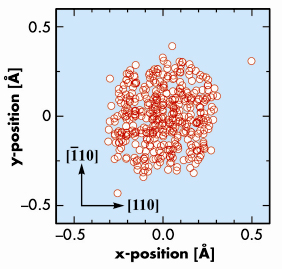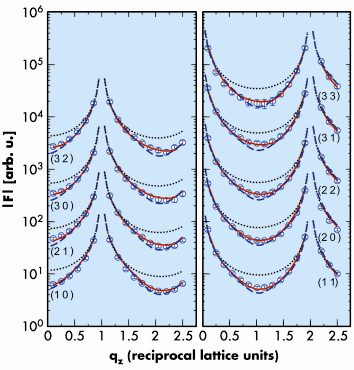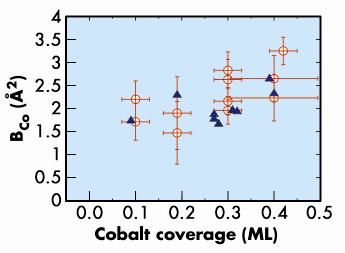- Home
- Users & Science
- Scientific Documentation
- ESRF Highlights
- ESRF Highlights 2008
- Surface and interface science
- X-ray study of mesoscopic relaxations in cobalt nanoislands on Cu(001)
X-ray study of mesoscopic relaxations in cobalt nanoislands on Cu(001)
Many atoms within nanostructures experience reduced coordination when compared to the bulk. This leads to strongly-modified chemical and physical properties, one being the rearrangement of the atoms in the structure. Despite its fundamental importance, knowledge of the atomic geometry in nanostructures is quite scarce. The interatomic distance represents the most important parameter and a theoretical study [1] on cobalt nanoislands on Cu(001) consisting of several tens of atoms has predicted that the interatomic distance is dramatically reduced from d = 2.51 Å for the bulk to values in the 2.4 Å range, i.e. considerably exceeding “usual” relaxations known for surfaces.
To provide direct evidence for the relaxations, we studied the registry of the cobalt-atoms with the Cu(001) substrate at beamline 33-ID-D (Advanced Light Source, ANL, USA) and at beamline ID03. In contrast to the common view that Co-atoms reside in hollow sites at a distance of d = 2.56 Å characteristic for the Cu(001) surface, a shortened interatomic distance (d = 2.40 Å) implies that cobalt atoms are not only located in hollow sites but also occupy low symmetry positions off the hollow site.
Figure 96 shows the positions of 431 cobalt atoms within the surface unit cell derived from molecular dynamics calculations. The distribution of the cobalt atoms around the hollow site at (x,y) = (0,0) can be approximated by a Gaussian function of half width at half maximum of <u> = 0.18 Å, corresponding to a Debye parameter of B = 8![]() <u2> = 2.56 Å2. The determination of the static disorder of the adsorbed Co-atoms is the basis of the X-ray analysis.
<u2> = 2.56 Å2. The determination of the static disorder of the adsorbed Co-atoms is the basis of the X-ray analysis.
 |
|
Fig. 96: Molecular dynamics calculation showing the positions of cobalt atoms in the Cu(001) unit cell. The centre at (x,y) = (0,0) corresponds to the hollow site. |
The registry of the cobalt atoms is probed by the analysis of the intensity distribution along the substrate reflections, which are referred to as crystal truncation rods (CTR’s). The CTR’s arise from the termination of the crystal leading to a continuous intensity distribution, [I(qz)] between the bulk Bragg-reflections. Figure 97 shows the structure factor amplitudes (|F| ![]()
![]() I) along several CTR’s. Dotted lines represent the calculated |F|-values for clean Cu(001), while solid and dashed lines are fits to the data (symbols) assuming hollow site adsorption with and without disorder of the cobalt atoms, respectively. The solid line fits the data best especially close to the minima along the CTR’s, which is the most surface sensitive position. Figure 98 summarises the cobalt Debye-parameters B versus coverage. We find values in the B = 2.5 Å2 range, in excellent agreement with calculated values shown as triangles. In summary, the analysis of the static disorder of surface adsorbed cobalt atoms on Cu(001) in combination with molecular- dynamics calculations based on STM images has provided experimental evidence for large contractions of the interatomic cobalt distances in monoatomic nanoislands.
I) along several CTR’s. Dotted lines represent the calculated |F|-values for clean Cu(001), while solid and dashed lines are fits to the data (symbols) assuming hollow site adsorption with and without disorder of the cobalt atoms, respectively. The solid line fits the data best especially close to the minima along the CTR’s, which is the most surface sensitive position. Figure 98 summarises the cobalt Debye-parameters B versus coverage. We find values in the B = 2.5 Å2 range, in excellent agreement with calculated values shown as triangles. In summary, the analysis of the static disorder of surface adsorbed cobalt atoms on Cu(001) in combination with molecular- dynamics calculations based on STM images has provided experimental evidence for large contractions of the interatomic cobalt distances in monoatomic nanoislands.
 |
|
Fig. 97: Crystal Truncation Rods for 0.3 monolayer cobalt on Cu(001). Symbols and lines correspond to experimental and calculated structure factor amplitudes, respectively. Curves are shifted vertically for clarity. |
 |
|
Fig. 98: Experimentally-derived Debye parameters BCo of cobalt atoms (circles) versus coverage. Triangles represent corresponding values determined by molecular dynamics calculation. |
Principal publication and authors
O. Mironets (a), H.L. Meyerheim (a), C. Tusche (a), V.S. Stepanyuk (a), E. Soyka (a), P. Zschack (b), H. Hong (b), N. Jeutter (c), R. Felici (c), and J. Kirschner (a), Phys. Rev. Lett. 100, 096103 (2008).
(a) Max-Planck-Institut f. Mikrostrukturphysik, D-06120 Halle (Germany)
(b) APS, Argonne National Laboratory, Argonne, IL 60439 (USA)
(c) ESRF
Reference
[1] V.S. Stepanyuk, D.I. Bazhanov, A.N. Baranov, W. Hergert, P.H. Dederichs, and J. Kirschner, Phys. Rev B 62, 15398 (2000).



